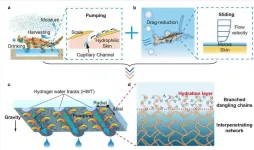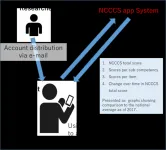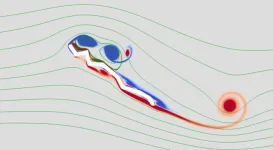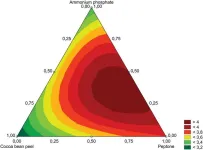Highly oriented perovskite films induced by chiral molecules under magnetic-field control
2024-01-26
(Press-News.org)
In the realm of clean energy, metal halide perovskite solar cells (PSCs) have emerged as a groundbreaking focus, capturing significant attention for their extraordinary advancements. In just over a decade, their certified power conversion efficiency (PCE) has skyrocketed to 26.1%, approaching the upper limits seen in traditional crystalline silicon cells. What sets PSCs apart is their potential to surpass the 30% PCE threshold [1].
The key to optimizing solar devices lies in the deposition of high-quality perovskite films. Achieving minimal defect density and exceptional homogeneity becomes crucial for enhancing device performance. One commonly employed strategy involves introducing specific molecules [2, 3] during perovskite film crystallization to eliminate defects or prevent excessive components. However, conventional passivation strategies in perovskite (ABX3) photovoltaics pose limitations on the interaction between passivation molecules and sites A, B, and X.
At the core of perovskite crystallization regulation is the lead-iodine octahedral structure. Manipulating this process involves incorporating appropriate functional groups, facilitating the formation of uniform polycrystalline films with exceptional crystal orientation [4]. The unique molecular configuration of perovskites presents an opportunity to influence crystallization orientation by modulating the polarity between the perovskite material and introduced components [5]. For example, the rotational motion of the A-site offers a means to strengthen the interaction between passivation molecules and perovskites, especially in the presence of an external field.
In this exciting context, a pioneering method was introduced to manipulate the crystal orientation of metal halide perovskites, by Prof. Wang’s group from Soochow University. They introduced a set of chiral molecules and, using the inherent properties of the chiral molecules, established a quantified strong force between the chiral molecules and formamidine (FA) ions in perovskite, called the magnetic dipole moment. As shown in the figure, the δ phase harmful to the device will inevitably be produced in the crystallization of conventional perovskite films, and the simple use of chiral passivation molecules can effectively regulate the composition of perovskite films, but the existence of magnetic dipole moments is not strong enough to play a role, and the orderly arrangement of the overall structure cannot be guaranteed. However, the application of an external magnetic field can effectively enhance and regulate this effect, based on the spin-orbit coupling effect, so that the crystal orientation in the perovskite film can be precisely adjusted while optimizing the composition. Combined with theoretical computational support from Ilhan Yavuz et al., Marmara University, they further demonstrated the feasibility of this collaborative strategy.
In comparison to conventional passivation strategies involving the direct implementation of organic molecules, this method shows a significant increase in the interaction energy between chiral molecules and perovskites by several times. This substantial improvement ensures effective crystallization regulation and achieves a uniform perovskite film. With the assistance of Xingyu Gao et al. from the Shanghai Synchrotron Radiation Facility, they used in situ crystallization process detection technology to observe a significant improvement clearly and comprehensively in the quality of perovskite films under the synergistic effect. These evidences fully prove the effectiveness of the collaborative strategy from both theoretical and experimental aspects, which significantly inhibits the possible defects in the device, and further greatly improves the performance of the photovoltaic device.
Furthermore, the stability of devices is successfully preserved. This groundbreaking advancement not only boosts the efficiency of solar cells but also ensures their reliability over prolonged periods, marking a significant stride towards a more sustainable and efficient future in solar energy utilization.
###
See the article:
Existence and mechanism of the magnetic dipole moment between perovskites and chiral molecules
https://doi.org/10.1093/nsr/nwad305
[1] NREL Effiency. https://www.nrel.gov/pv/assets/images/cell-pv-eff-emergingpv.png (23 November 2023, data last accessed)
[2] Huang Z, Bai Y, and Huang X et al. Nature 2023; 623: 531–7.
[3] Yang Z, Ma F, and Qu ZH et al. Science 2022; 377: 531-4.
[4] Luo C, Zheng GHJ, and Gao F et al. Joule 2022; 6: 240-57.
[5] Meloni S, Moehl T, and Tress W et al. Nat Commun 2016; 7: 10334.
END
[Attachments] See images for this press release:
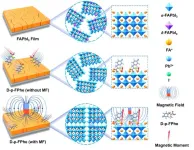
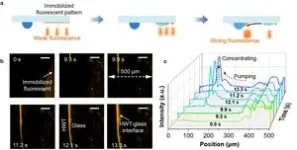
ELSE PRESS RELEASES FROM THIS DATE:
2024-01-26
This study, led by Prof. Jiuhui Qu, Dr. Qinghua Ji, and Dr. Wei Zhang from Tsinghua University, focuses on addressing water scarcity by exploring atmospheric water harvesting. The water in the air originates from both natural and forced evaporation, with condensation being the final and crucial step in water harvesting. Condensation involves nucleation, growth, and shedding of water droplets, which are then collected. However, uncontrollable growth of condensed droplets leading to surface flooding is a pressing challenge due to insufficient driving forces, posing a threat to sustainable condensation.
To expedite this process and achieve orderly ...
2024-01-26
To improve the care coordination competency of nurses involved in the management of critically ill patients on life support, an electronic app—NCCCS—was developed by Associate Professor Chie Takiguchi of Toho University and Professor Tomoko Inoue of International University of Health and Welfare.
The NCCCS app utilizes the scoring system referred to as the Nurses' Care Coordinate Competency Scale (NCCCS), developed by Dr. Takiguchi et al. in 2017, and it is currently being translated into Chinese, Italian, Polish, and Persian. This app offers immediate feedback to nurses caring for critically ill patients on life ...
2024-01-26
Scientists from Hiroshima University undertook a study of dragonfly wings in order to better understand the relationship between a corrugated wing structure and vortex motions. They discovered that corrugated wings exhibit larger lift than flat wings.
Their work was published in the journal Physical Review Fluids on December 7, 2023.
The researchers set out to determine if the corrugation of a dragonfly's wing is a secret ingredient for boosting lift. While past research has largely zoomed in ...
2024-01-26
Amylases are among the most important biotechnological and industrial enzymes that can be applied in various sectors, such as food, pharmaceuticals, textiles, chemicals, paper, and detergents.
The enzymes’ costs come from a range of factors including the quantity produced, the production process, the expense of its recovery, and the degree of purity at which it will be marketed, etc. The use of agro-industrial substrates and microorganisms brings the potential to low-cost enzyme production. Meanwhile, due to the ability to improve physical and chemical resistance to industrial environmental extremes, such as high temperature and pH, as well ...
2024-01-26
Staying hydrated and consuming appropriate amounts of salt is essential for the survival of terrestrial animals, including humans. The human brain has several regions constituting neural circuits that regulate thirst and salt appetite, in intriguing ways.
Previous studies suggested that water or salt ingestion quickly suppresses thirst and salt appetite before the digestive system absorbs the ingested substances, indicating the presence of sensing and feedback mechanisms in digestive organs that help real-time thirst and salt appetite modulation in response to drinking ...
2024-01-26
Early in the pandemic, clinicians noticed that certain immunocompromised patients were experiencing persistent SARS-CoV-2 infections, some lasting weeks to months at a time.
This raised concerns that one of these cases could be the source of an emerging viral variant that has benefited from an extended battle with the immune system.
A prospective study published in the journal Lancet Microbe provides more clarity on which patient populations are at higher risk for prolonged infections —and hints that this fear is likely unwarranted.
The ...
2024-01-26
A new statistical tool developed by researchers at the University of Chicago improves the ability to find genetic variants that cause disease. The tool, described in a new paper published January 26, 2024, in Nature Genetics, combines data from genome wide association studies (GWAS) and predictions of genetic expression to limit the number of false positives and more accurately identify causal genes and variants for a disease.
GWAS is a commonly used approach to try to identify genes associated with a range of human traits, including most common diseases. Researchers compare genome sequences ...
2024-01-26
As part of the Ice Memory initiative, PSI researchers, with colleagues from the University of Fribourg and Ca’ Foscari University of Venice as well as the Institute of Polar Sciences of the Italian National Research Council (CNR), analysed ice cores drilled in 2018 and 2020 from the Corbassière glacier at Grand Combin in the canton of Valais. A comparison of the two sets of ice cores published in Nature Geoscience shows: Global warming has made at least this glacier unusable as a climate archive.
Reliable information about the past climate and air pollution can no longer be obtained from ...
2024-01-26
A valuable molecule sourced from the soapbark tree and used as a key ingredient in vaccines, has been replicated in an alternative plant host for the first time, opening unprecedented opportunities for the vaccine industry.
A research collaboration led by the John Innes Centre used the recently published genome sequence of the Chilean soapbark tree (Quillaja saponaria) to track down and map the elusive genes and enzymes in the complicated sequence of steps needed to produce the molecule QS-21.
Using transient expression techniques developed at the John Innes Centre, the team reconstituted the ...
2024-01-26
As digital devices progressively replace pen and paper, taking notes by hand is becoming increasingly uncommon in schools and universities. Using a keyboard is recommended because it’s often faster than writing by hand. However, the latter has been found to improve spelling accuracy and memory recall.
To find out if the process of forming letters by hand resulted in greater brain connectivity, researchers in Norway now investigated the underlying neural networks involved in both modes of writing.
“We ...
LAST 30 PRESS RELEASES:
[Press-News.org] Highly oriented perovskite films induced by chiral molecules under magnetic-field control


